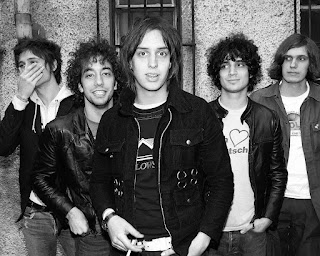There’s something oddly satisfying about listening to a legendary album and thinking, “Really? This is what turned the indie rock world inside out?” That, in a nutshell, was my experience revisiting Is This It, the Strokes’ 2001 debut that critics still treat like it cured polio. For me, it was less a seismic rock event and more a tinny jangle of detached coolness dressed up as minimalist genius. The hype, the skinny jeans, the garage rock resurrection, they all promised a holy experience. What I got instead was a nasal shrug with a backbeat.
Let’s rewind. In the late ‘90s, a few prep-school buddies in New York got together and decided they were going to make rock music sound cool again. And not cool like technically good or sonically innovative, just cool in that skinny, blasé, cigarette-dangling-from-the-lip way that made disaffected youth and PR reps swoon. With a name like Julian Casablancas and a Rolodex that included boarding school pals and Velvet Underground vinyls, they built a band out of attitude and distortion pedals. Enter The Modern Age, an EP that caught fire in the UK and turned the Strokes into messianic figures of a guitar rock revival no one quite remembered asking for.
They signed with RCA after a bidding war that made them the belle of the indie ball, despite the fact that half their demos sounded like they were recorded in a lunchbox. After trying to work with a real producer (Pixies alum Gil Norton), they ditched the polished approach for Gordon Raphael’s dingy East Village basement studio. The vibe was low-fi, high-smug. Their goal? Capture the raw, gritty energy of a live set. The result? Eleven tracks that sound like someone EQ’d them using an old rotary phone.
The production, while often lauded as revolutionary in its simplicity, just sounds unfinished to me. “Raw efficiency” is one way to put it; “half-baked demo tape” is another. Casablancas apparently sang through a tiny Peavey amp to achieve “authenticity.” That’s charming in theory but grating in practice. The guitars, recorded with such Spartan minimalism that it bordered on masochism, mostly bounce between repetitive riffs and fuzzed-out noodling that evokes the musical equivalent of an eye roll. The drums? Three mics, no frills, and a lot of “clink-clink-boom” that fades into background static. It’s like hearing a band jam through a broom closet.
As for songwriting, Casablancas wanted to be profound but came off like a guy who scribbled lyrics during his lunch break while watching people avoid eye contact on the subway. Themes include urban ennui, meaningless sex, drugs, and a general sense of existential meh. Deeply poetic stuff like: “I want to be forgotten, and I don’t want to be reminded.” That line, folks, is as close to self-awareness as this record gets.
Track by Track (or “Eleven Shades of Indifference”):
“Is This It” – A sedated opener that limps in with a drumbeat so sleepy it may qualify as ambient noise. Casablancas sounds like he’s been tranquilized mid-mumble.
“The Modern Age” – Tries to be urgent, ends up just anxious. Riff repetition like a cat walking across a keyboard.
“Soma” – Aldous Huxley called; he wants more imagination. Gimmicky stop-start rhythms and lyrical references that feel like they were Googled.
“Barely Legal” – Uncomfortably smug and lyrically cringey. You’ll want to shower after listening, and not in a good way.
“Someday” – A brief shimmer of catchiness, with rockabilly touches. Not bad, just tragically surrounded.
“Alone, Together” – Has a guitar hook and a heartbeat, but its energy fizzles by the second chorus.
“Last Nite” – The prom king of this album. Infectious riff, pop-friendly, and just fine. But it’s the best song here the way Taco Bell is the best option on a deserted highway.
“Hard to Explain” – A fan favorite that sounds like it was mixed through a tin can. Could’ve been a jam, isn’t.
“New York City Cops” – Removed post-9/11, which only added to its faux-rebel mystique. The song itself is just chaotic posturing.
“Trying Your Luck” – More mood than melody. It’s a sigh of a song.
“Take It or Leave It” – The closest thing to an exclamation point on this album. Sadly, it’s still a shrug.
Reception-wise, the critics salivated. Metacritic slapped a 91 on it, NME practically anointed it a deity, and Rolling Stone issued glowing praise as if Lou Reed himself had risen and given them marching orders. It was hailed as a “revolution,” though in retrospect, it feels more like a stylish diversion from the grunge hangover. To its credit, Is This It did help kick off a movement, Arctic Monkeys, Franz Ferdinand, Interpol, and Kings of Leon all owe a debt. But the Strokes were less prophets than poster boys. They had the haircuts, the jeans, and the lineage. The music? Meh.
Today, Is This It occupies a strange cultural position, endlessly cited, rarely replayed. It’s the indie rock equivalent of a MySpace profile: important at the time, faintly embarrassing in hindsight. Sure, it made room for guitar bands in the early 2000s, but so did Guitar Hero. If you’re nostalgic for a time when a disinterested stare and a tight riff could spark a thousand fawning think pieces, this is your album. Otherwise, you may find yourself asking, “Is this it?” and realizing, unfortunately, that the answer is yes.
⭐️⭐️ (2/5)
#TooCoolToCare #GarageRockLetdown #StrokedOut #HipsterHolyGrail #BuzzcutBeats #StyleOverSubstance #IndieDarlingsUnderwhelmed #NYCEnnuiAnthem






No comments:
Post a Comment